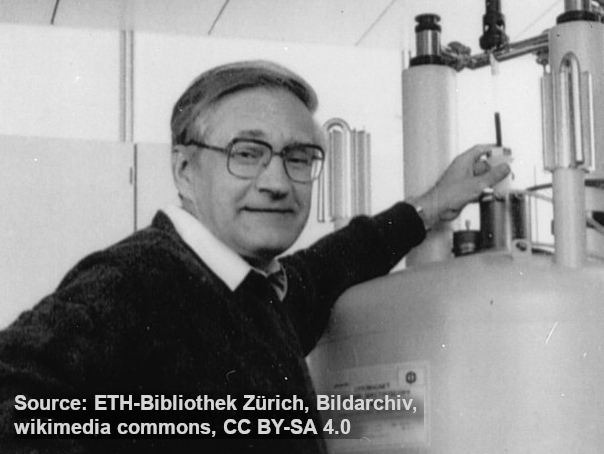Professor Richard R. Ernst, Swiss Federal Institute of Technology (ETH) Zurich, Switzerland, passed away on June 4, 2021. He will be remembered as a personality who rendered great services to ETH, science, and society.
The Nobel Prize in Chemistry 1991 was awarded to the Swiss physical chemist “for his contributions to the development of the methodology of high resolution nuclear magnetic resonance (NMR) spectroscopy.” He developed two-dimensional NMR and several novel pulse techniques. In collaboration with Kurt Wüthrich, ETH Zurich, he made important contributions to the development of the NMR structure determination method of biopolymers in solution. As a further development of NMR, Richard Ernst laid the foundations for magnetic resonance imaging (MRI), an imaging technique for visualizing tissues and organs in the body.
Richard R. Ernst, born in Winterthur, Switzerland, studied chemical engineering at ETH Zurich, Switzerland, and received his Ph.D. there in physical chemistry in 1962 for work on nuclear magnetic resonance spectroscopy with stochastic radiofrequency fields. From 1962 to 1968, he was a researcher at Varian Associates, Palo Alto, CA, USA, where he invented Fourier transform NMR, noise decoupling, and a number of other methods. In 1968, he returned to ETH Zurich and established a research group in NMR spectroscopy with emphasis on methodological developments in liquid and solid phases. Since 1976, Richard R. Ernst was Full Professor of Physical Chemistry and in 1998, he became Emeritus Professor.
In addition to the Nobel Prize, Richard R. Ernst has received numerous other awards, including the Wolf Prize in 1991 and the Marcel Benoist Prize in 1985. He holds 17 honorary doctorates from, e.g., the ETH Lausanne, Switzerland, the TU Munich, Germany, the University of Zurich, Switzerland, the University of Antwerp, Belgium, the Babeș-Bolyai University of Cluj, Romania, and the University of Montpellier, France. He was a Member of the U.S. National Academy of Sciences, Foreign Member of the Royal Society, London, UK, the German Academy of Sciences Leopoldina, the Russian Academy of Sciences, the Korean Academy of Science and Technology, the Academia Europaea, the American Academy of Arts and Sciences, and Honorary Member of many other societies. Since 1998, the Magnetic Resonance Spectroscopy Division of the German Chemical Society (GDCh) has awarded an annual prize named after him to three young scientists.
Selected Publications
- Kernresonanz-Spektroskopie mit stochastischen Hochfrequenzfeldern
R. R. Ernst,
Ph.D. Thesis, Eidgenössische Technische Hochschule Zürich, Switzerland, 1962.
https://doi.org/10.3929/ethz-a-000091764 - Application of Fourier Transform Spectroscopy to Magnetic Resonance,
R. R. Ernst, W. A. Anderson,
Rev. Sci. Instrum. 1966, 37, 93–102.
https://doi.org/10.1063/1.1719961 - Measurement and Control of Magnetic Field Homogeneity,
R. R. Ernst,
Rev. Sci. Instrum. 1968, 39, 998–1012.
https://doi.org/10.1063/1.1683586 - Two‐dimensional spectroscopy. Application to nuclear magnetic resonance,
W. P. Aue, E. Bartholdi, R. R. Ernst,
J. Chem. Phys. 1976, 64, 2229–2246.
https://doi.org/10.1063/1.432450 - Nuclear Magnetic Resonance Fourier Transform Spectroscopy (Nobel Lecture),
R. R. Ernst,
Angew. Chem. Int. Ed. 1992, 31, 805–823.
https://doi.org/10.1002/anie.199208053 - Local monitoring of proton spin diffusion in static and rotating samples via spy detection
S. Zhang, B. H. Meier, R. R. Ernst,
Solid State Nucl. Magn. Reson. 1993, 1, 313-320.
https://doi.org/10.1016/0926-2040(93)90013-D - A Chemist Remains a Chemist,
R. R. Ernst,
Angew. Chem. Int. Ed. 2013, 52, 61–67.
https://doi.org/10.1002/anie.201205461
Also of Interest
- Richard R. Ernst, Autobiografie, Hier und Jetzt Verlag, Zürich, Switzerland 2020. ISBN: 978-3-03919-501-5




